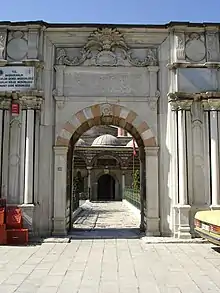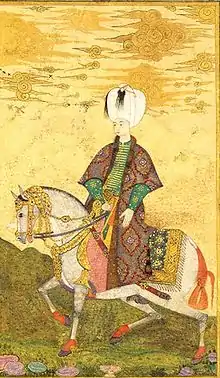Mahfiruz Hatun
Mahfiruz Hatun[1] (from Persian ماه فيروز Mâh-e Farūza "Glorious moon"[a] or Mâh-e Rûza "Daytime moon", c. 1590 – by 1610 or 1620) was a concubine of Ottoman Sultan Ahmed I (r. 1603–17) and mother of Sultan Osman II (r. 1618–22).
| Mahfiruz | |||||
|---|---|---|---|---|---|
 The tomb place of Mahfiruz Hatun is located at the heights of Golden Horn inside Eyüp Cemetery in Eyüp, Istanbul | |||||
| Born | c. 1590 | ||||
| Died | by 1610 or c. 1620 Topkapı Palace, Istanbul, Ottoman Empire | ||||
| Burial | |||||
| Spouse | Ahmed I | ||||
| Issue | Osman II Şehzade Bayezid Şehzade Hüseyin | ||||
| |||||
| Religion | Islam | ||||
Life
According to historian Baki Tezcan, nothing is known about her except her probable name and period of death.[2][b] Her court name, Mahfiruz, means "Glorious crescent" in Persian. Such names were given to the women of the Imperial Harem.[3]
She was the first of Ahmed I's three women and bore him Osman II. With the birth of Osman, the couple's first child, Ahmed became the youngest Ottoman sultan to become father, and Osman was the first Ottoman first-born prince to be born in the Imperial capital of Istanbul.[4]
- Issue
- Sultan Osman II (3 November 1604, Istanbul, Topkapı Palace – murdered by janissaries, 20 May 1622, Istanbul, Topkapı Palace, buried in Ahmed I Mausoleum, Sultan Ahmed Mosque)[5][6] Sultan of the Ottoman Empire;
- Şehzade Bayezid (November 1612 – murdered by Murad IV, 27 July 1635, Constantinople, Topkapı Palace, buried in Ahmed I Mausoleum, Sultan Ahmed Mosque);[5][6]
- Şehzade Hüseyin (November 1614, Constantinople – after 1622, Constantinople, Topkapı Palace, buried in Mehmed III Mausoleum, Hagia Sophia Mosque).[5][6]
Assessment by Peirce
The date of her death is undetermined. There are evidence that strongly suggests that she died at the latest by 1610.[2] According to Leslie P. Peirce, she was alive when Osman was enthroned as sultan in 1618 after the deposition of incompetent Mustafa I; Peirce believes that she was not living in the palace during his son's reign nor did she act as valide sultan, as privy purse registers listed no valide sultan during Osman's reign.[7] Also from the middle of 1620, Osman's governess, the daye hatun, began to receive an extraordinary large stipend, one thousand aspers a day rather than her usual two hundred aspers, an indication that she was now the official stand-in for the Valide Sultan.[7] Mahfiruz may have fallen out of favour, judging by her absence in the palace and burial in Eyüb rather than with her husband, and never have recovered her status as a royal consort.[7] Venetian ambassador Contarini reported the beating of a woman who had irritated Kösem, ordered by the sultan, in 1612, which may be identified to Mahfiruz.[7] She may have been a rival of Kösem, who made efforts to keep Mustafa safe from execution, and saw an obstacle in Mahfiruz.[7] She was buried in the large sanctuary of Eyüp, Istanbul.[7]
In popular culture
In the 2015 Turkish television series Muhteşem Yüzyıl: Kösem, Mahfiruz was portrayed by actress Ceyda Olguner. Historical advisors to the series noted that Mahfiruz was a Circassian by birth. In the fifth episode of the first series, the character was recast with actress Dilara Aksüyek and introduced as "Çerkes güzeli Raşa" (Circassian beauty Rasha) before being renamed to Mahfiruz (Mahfiruze).[8]
Annotations
References
- Sakaoğlu, Necdet (2008). Bu mülkün kadın sultanları: Vâlide sultanlar, hâtunlar, hasekiler, kadınefendiler, sultanefendiler. Oğlak Publications. p. 238. ISBN 978-9-753-29623-6.
- Tezcan 2007, p. 350.
- Paulus Cassel (1888). An Explanatory Commentary on Esther: With Four Appendices Consisting of the Second Targum Translated from the Aramaic with Notes : Mithra : the Winged Bulls of Persepolis : and Zoroaster. T. & T. Clark. p. 56.
favourite of the crescent
- Baki Tezcan (13 September 2010). The Second Ottoman Empire: Political and Social Transformation in the Early Modern World. Cambridge University Press. pp. 115–. ISBN 978-0-521-51949-6.
- Şefika Şule Erçetin (28 November 2016). Women Leaders in Chaotic Environments:Examinations of Leadership Using Complexity Theory. Springer. p. 77. ISBN 978-3-319-44758-2.
- Mustafa Çağatay Uluçay (2011). Padışahların Kadınları ve Kızları. Ötüken, Ankara. p. 78. ISBN 978-9-754-37840-5.
- Peirce 1993, p. 233.
- Fındık, Nida (10 December 2015). "Muhteşem Yüzyıl Kösem". Noluyo.tv (in Turkish). Istanbul. Archived from the original on 11 February 2016. Retrieved 7 March 2017.
- Çakıroğlu, Ekrem (1999). Osmanlılar ansiklopedisi. Yapı Kredi Kültür Sanat Yayıncılık. p. 53. ISBN 978-975-08-0071-9.
Hatice Mâhferūza, Mâhferūz, Mâh-e Fay'rūz
(Mâh-ı Fey'rûz in Persian means Mâh=Moon and Fay'rūz=daytime shadow.) - İsmail Metin (2010). Osmanlı sarayında cinsel sapkınlıklar. Parşömen Yayınları. p. 179. ISBN 978-605-4452-20-0.
Birinci Ahmet'in gözdelerinden ilki Evdoksia idi.
- Tezcan, Baki (2002). "The 1622 Military Rebellion in Istanbul : A Historiographical Journey". International Journal of Turkish Studies. University of Wisconsin: 40.
Stanford Shaw, the author of an Ottoman history that has been widely used as a textbook and reference work, claims, on the basis of information from an eighteenth-century French novel,84 that the sultan was "[t]rained in Latin, Greek, and Italian by his Greek mother, as well as Ottoman Turkish, Arabic, and Persian."85
Sources
- Peirce, Leslie P. (1993). The Imperial Harem: Women and Sovereignty in the Ottoman Empire. Oxford University Press. pp. 233–. ISBN 978-0-19-508677-5.CS1 maint: ref=harv (link)
- Tezcan, Baki (2007). "The Debut of Kösem Sultan's Political Career". Turcica. Éditions Klincksieck. 39–40: 350.CS1 maint: ref=harv (link)
- Nazım Tektaş (2004). Harem'den taşanlar. Çatı. pp. 183–185. ISBN 978-975-8845-02-6.

